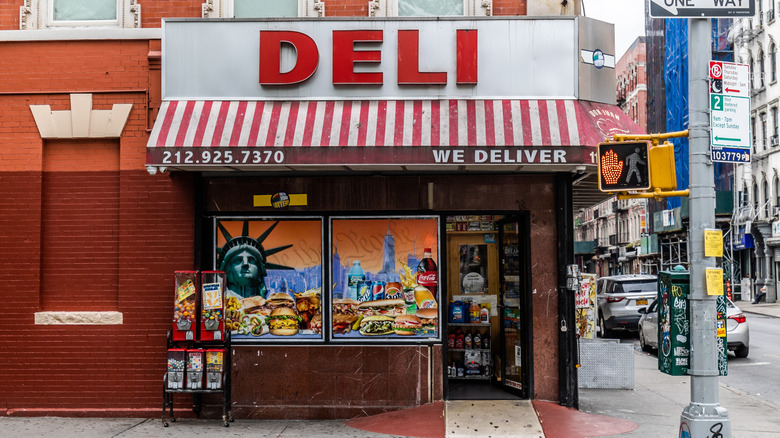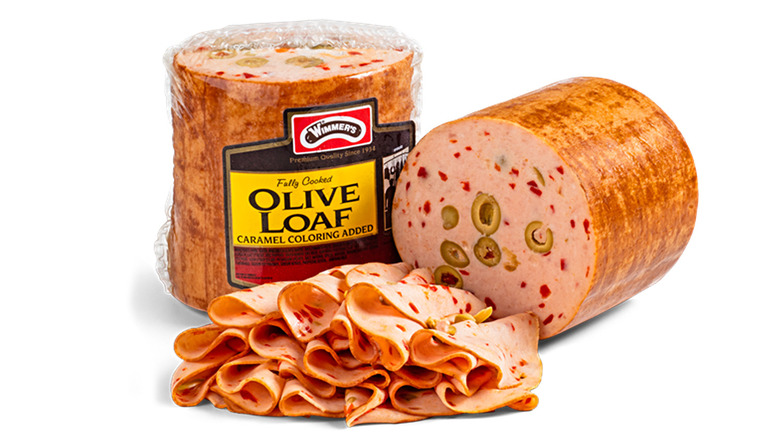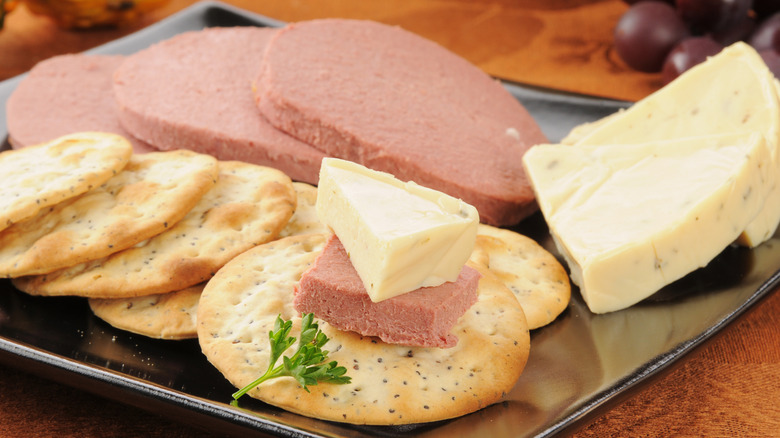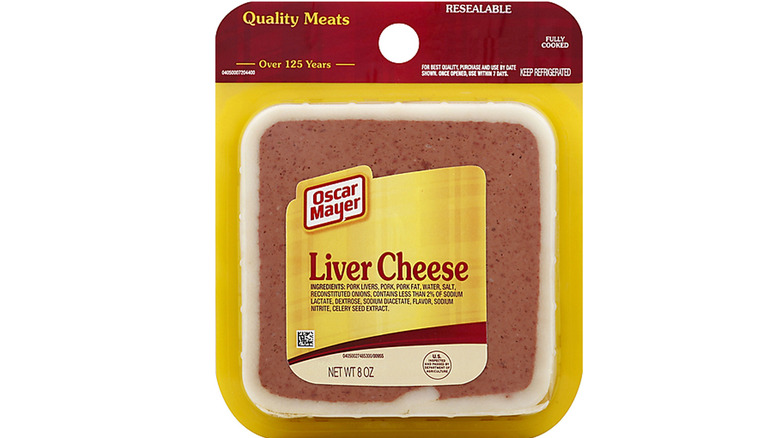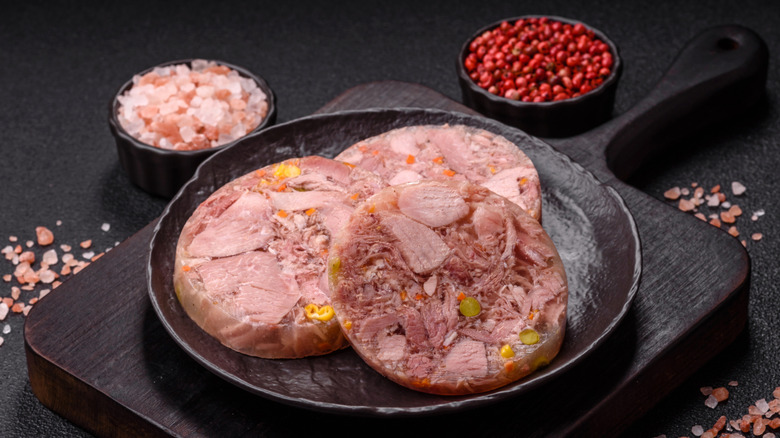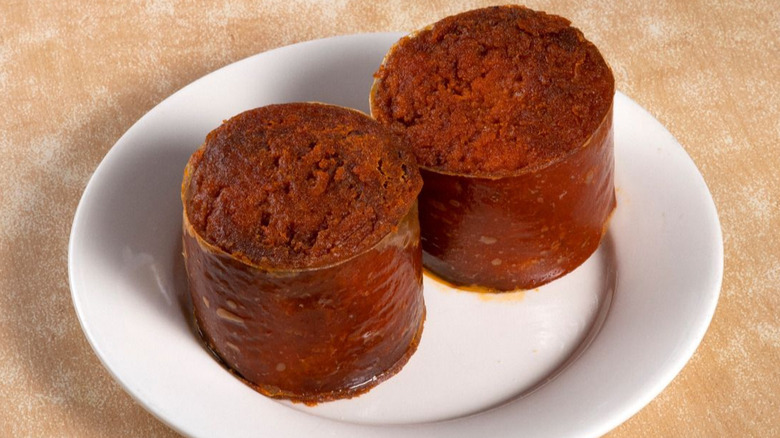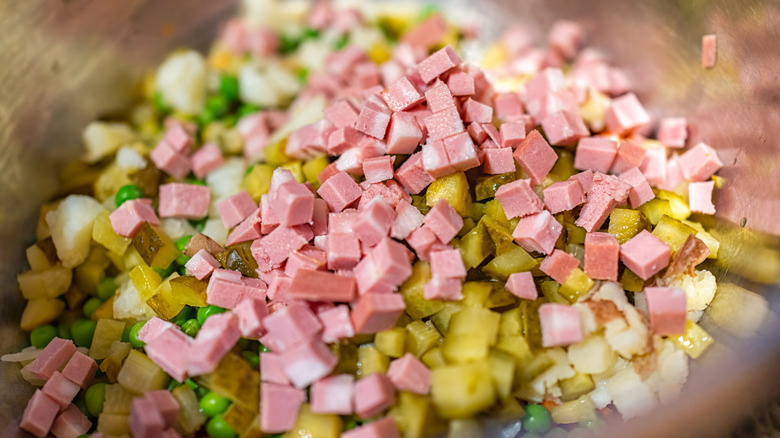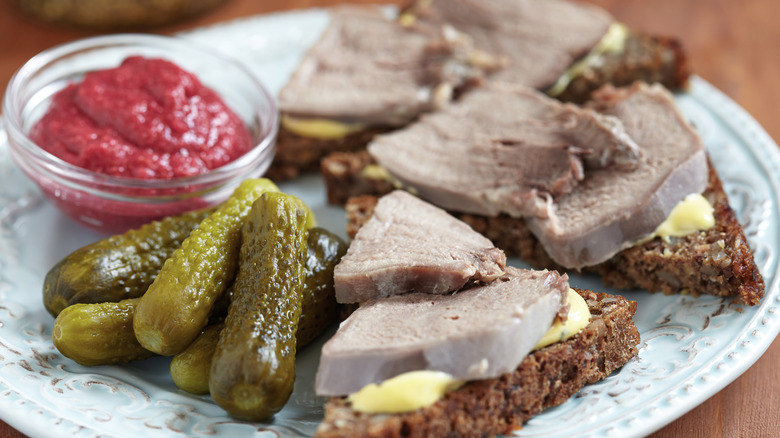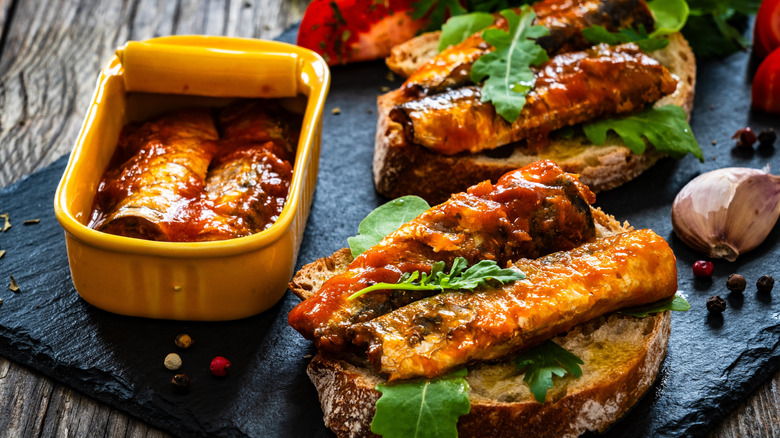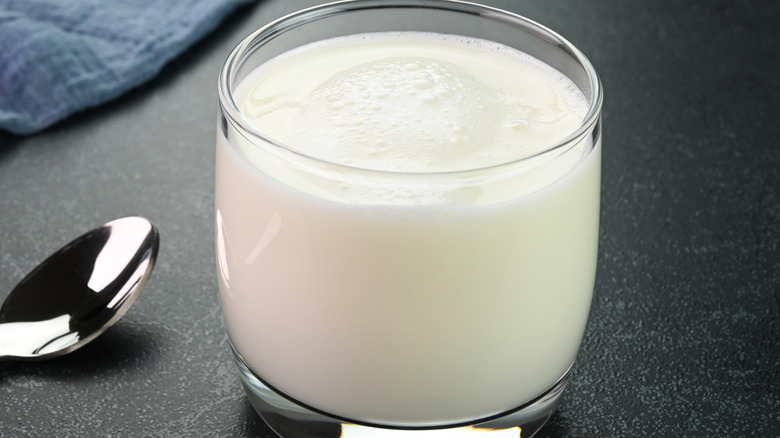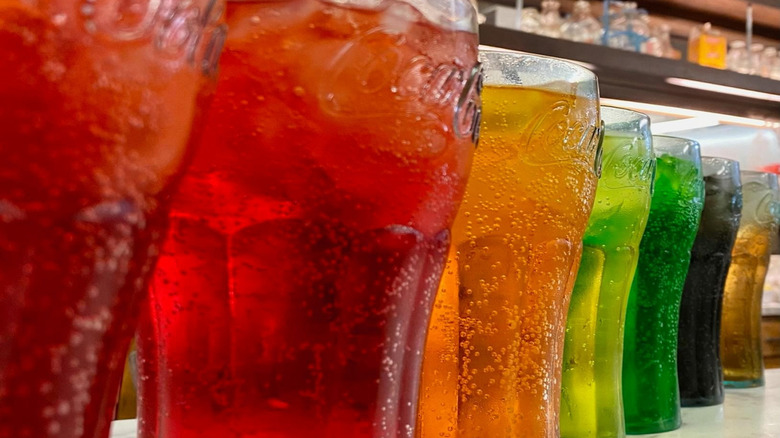Old-School Deli Orders That Americans Used To Love
Most good modern-day delis are at least a little old-school in nature. Whether that means a numbered ticket-based ordering system, a predominately older clientele, or just a kind of vintage aesthetic, delis are typically pretty retro in one way or another. That said, the types of foods that are popular at even the absolute best delis in the U.S. have, naturally, changed a whole lot over the decades.
For an item to qualify for this list of old-school deli orders, it simply has to have declined in popularity. That doesn't mean it's impossible to find nowadays — in most cases, these items are still available, albeit mostly just to those who know where to look. Based on that simple criteria, then, Americans used to love ordering each of the items on this list at delis, but these orders have either become an oddity or outright gone extinct in the present day.
Olive loaf
Occasionally making the rounds in online communities dedicated to vintage foods is an image of Oscar Mayer's lunch meat lineup in the 1970s. Some of the items pictured are specific to Oscar Mayer, like a mysterious "luxury loaf." One offering not unique to Oscar Mayer but a relic of times past nevertheless is olive loaf. Typically, olive loaf is made from pork, and possibly incorporates other meats. Embedded within its meaty base are, naturally, olives.
Whenever discussions of olive loaf pop up online, plenty of commenters recount how the meat was a staple of their childhood. Olive loaf is still found at some delis, but it is clearly not as widely available as it was when Oscar Mayer featured it as a marquee lunch meat. One Reddit user posted that olive loaf is equivalent to childhood nostalgia. "I haven't had it since my grandparents gave it to us 40 years ago but I loved it then," they wrote. "Next time I'm at the deli counter I'm picking up a ½ pound to see if it's as good as I remember it."
Braunschweiger
In a general sense, it's safe to say liver is less prominent today than it was in restaurants once upon a time. Liver and onions specifically is a once-popular food you won't see many people eating today. On a deli sandwich, one way to serve liver is in the form of a bulky sort of sausage, substantial enough for a slice to serve as a sandwich protein. Liverwurst is one common form for deli liver sausage to take, but perhaps even more reminiscent of times past is braunschweiger. Both liverwurst and braunschweiger incorporate pork and/or beef liver as well as spices like black pepper or mustard seed. Setting braunschweiger apart is the possibility that it might be smoked.
For what it's worth, liver aficionados readily acknowledge that the meat can be an acquired taste. With that said, plenty of those who grew up eating it still consider braunschweiger a delicacy and seek out the establishments that still serve it in the present day. "My parents did WeightWatchers back when WW required you to eat liver two times a week," wrote one Reddit user. "They kept a tube of braunschweiger in the fridge [because] it was about the only way they could stand liver. My sister and I would eat braunschweiger on Wonder bread; I liked to add iceberg lettuce. Every couple years, I find a deli that will put braunschweiger and lettuce on some good bread for me."
Liver cheese
Liverwurst and braunschweiger aren't the only liver-based deli meats that used to be amply stocked at American delis. Whereas those are technically considered sausages, liver cheese is a liver-based sandwich meat in processed loaf form. More than just sliceable liver meat, however, liver cheese is unique for incorporating a strip of pork fat that creates a border around the liver portion. Its name is a direct translation of the German word leberkäse, and beyond pork liver, pork fat, and pork, it's typically flavored with simple seasonings like salt or celery seed.
Like braunschweiger, liver cheese is something fans of the stuff still attempt to seek out at modern delis, despite its waning availability. "I've been checking and checking and I don't know why they stopped selling this at my local grocer. It was even a well known brand," wrote a Reddit user. "I loved this stuff as a kid when I could still find it!"
Head cheese
Liver cheese is a deli meat loaf made out of liver, and accordingly, head cheese is traditionally a deli meat loaf made of meat from an animal's head — usually pig. Scrapple is another meat found at some American delis made with head meat, but the difference between scrapple and head cheese is that the former is bound with cornmeal or buckwheat flour, whereas the latter utilizes a gelatin to maintain its form. Furthermore, modern-day head cheese isn't always made with just head meat, incorporating scraps from other parts of the animal in its gelatinous mass.
Some delis today still serve head cheese, but employees of those modern-day delis have shared that it's almost exclusively older customers seeking it out. Simply put, younger Americans don't seem to enjoy head cheese like older generations used to. "Worked in a deli/butcher shop for seven years and the only people to buy headcheese were 70-plus years old," wrote one Reddit user. "You have to have been trained to eat this s*** from a young age."
Kishka
Like liver cheese and head cheese, kishka is a deli meat traditionally made from an animal part that today might be considered unusual. Traditional Ashkenazi Jewish kishka revolves around a cow's intestine used as a sausage casing, within which is a mix of straight up fat and carbs — in this case, schmaltz, which is chicken fat that home chefs can repurpose before tossing, and matzo meal. Some non-Jewish Eastern European communities also make kishka, but given the intrinsic link between American delis and Jewish immigrants, the version encountered domestically is typically rooted in the Ashkenazi Jewish tradition.
Village Deli Restaurant in Los Angeles' Westwood Village is one spot that offered kishka on its menu back in 1970, as an affordable entree option. Kishka connoisseurs have recounted encountering the dish more often in years past, and a Reddit user shared an explanation for why exotic deli meats like kishka has declined in popularity. In short, it used to be more important to use every bit of a slaughtered cow because a single cow was intrinsically more valuable. "When there are fewer cattle and there's less reliable refrigeration, cattle are riskier to slaughter," they wrote. "Kishka, a popular addition to cholent (Shabbat stew), originally was cow intestine stuffed with filling and is now, in a wealthier and more squeamish community, made with a vegetarian casing."
Bologna salad/sandwich spread
Meat products like head cheese and kishka were effectively born of necessity. Rather than go to waste, the more undesirable portions of a slaughtered cow or pig were turned into something palatable. This philosophy basically also applies to a meat concoction that was a staple of old school delis and home kitchens alike, known as either bologna salad or sandwich spread. The dish revolves around leftover pieces of bologna too small for a sandwich. Those are ground up and mixed with mayo alongside ingredients that might go in, say, a chicken salad, like pickle relish or hard-boiled egg.
On a subreddit dedicated to all things nostalgic, a number of users described bologna salad or sandwich spread as a relic of their childhood. Detroit in particular was apparently a region where the dish was popular, including the suburb of Redford. "My grandparents lived in Redford for over 60 years, my mom bought that stuff all the time," wrote one Reddit user.
Tongue and egg salad sandwich
Jewish delis may be associated with the likes of pastrami and smoked salmon first and foremost, but tongue is another meat intrinsically linked to Jewish deli history. Today, it's still possible to find tongue at modern-day delis including some of the oldest delis in NYC, like Mill Basin Deli in Brooklyn. What's not so easy to find, if it still exists at all, is a tongue and egg salad sandwich.
Mid-City Delicatessen is one old-school Manhattan deli that offered its customers a tongue and egg salad sandwich in the 1950s at a 75 cent price point — its highest tier, which also included turkey and chopped chicken liver. Visitors to Richmond, Virginia's Perly's Delicatessen around 1970, meanwhile, could order a tongue and egg sandwich among various meat-and-egg combinations. Tongue was sold at a notably high price point there too. A Reddit user even recounted how tongue and egg salad sandwiches were offered at the very first Walgreens locations. "All menu items — from her chicken, tongue and egg salad sandwiches to bean or cream of tomato soup to the cakes and pies — were prepared by Myrtle Walgreen in their home kitchen," they wrote. "She rose at dawn and finished cooking by 11 a.m., and the food was then delivered fresh to Walgreens' two stores."
Sardine sandwich
The concept of sardines on bread or in a sandwich is far from novel in the present day. That said, such a snack is pretty much always enjoyed at home. Once upon a time, sardine sandwiches were a staple of American restaurants, including delis.
Today, grocery store sardines are notable for their high protein content at a price point significantly lower than competing animal products. Such was the case at vintage restaurants too — one old-school restaurant menu priced its sardine sandwich at 15 cents, equivalent to items like an American cheese or egg sandwich, and less than half the price of a chicken salad sandwich. As one of 12 once-popular sandwiches everyone ate in the 1950s, regulars of delis in decades past have shared memories of a time when the sardine sandwich was on the menu of practically every deli in the country. Americans haven't stopped eating sardines, of course, but their availability at delis has all but dissipated.
Buttermilk
Synonymous with New York Jewish delis are drinks like Dr. Brown's Cel-Ray soda and the chocolate egg cream, each of which simply isn't consumed all that much in other contexts. While those old-school deli drinks have remained relevant, plenty of delis back in the day used to offer customers buttermilk on drink menus as well. Of course, now, buttermilk just isn't really something most people drink on its own, let alone at a deli.
Buttermilk has changed in the past few centuries and the early Ashkenazi Jewish immigrants enjoyed buttermilk because the bacteria it contains makes it easier to consume than other dairy products for those with lactose intolerance. Meanwhile, old-school American health influencers have claimed that buttermilk helps fight the effects of aging. In essence, then, Jewish delis like Canter's in Los Angeles and even the kitschy Caesars' Noshorium Restaurant in Las Vegas most likely started offering buttermilk to customers due to its popularity among Ashkenazi Jews. Once the drink fell out of favor with the American public, as all fad health foods inevitably do, it stands to reason that its availability at delis began to wane.
Phosphate
As recently as the 1970s, alongside the likes of Dr. Brown's sodas and buttermilk, on the drink menus at some delis was something called a phosphate — while a staple of soda fountains, its simple recipe meant the drink could be found at a fair share of delis too.
The history of phosphate dates back to the late 1800s, and the heyday of phosphate sodas may well have been the '20s and '30s, when soda shops were a pillar of American life. In short, acid phosphate was developed as a shelf-stable alternative to citrus juices. It imparts drinks with a sour character, but without a distinctly citrusy flavor. Rather, it adds some saltiness. Phosphate sodas simply consisted of a soda base, sugar, phosphate, and a flavoring component like cherry or chocolate. In fact, one commenter in a Facebook thread about Jewish deli drinks recounted enjoying phosphate sodas with both flavors. "I wish I could get a chocolate phosphate with a drop of cherry like used to get when I was young," they wrote. "Now a glass of water is good."
